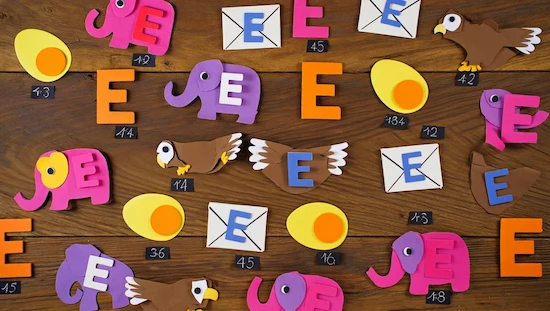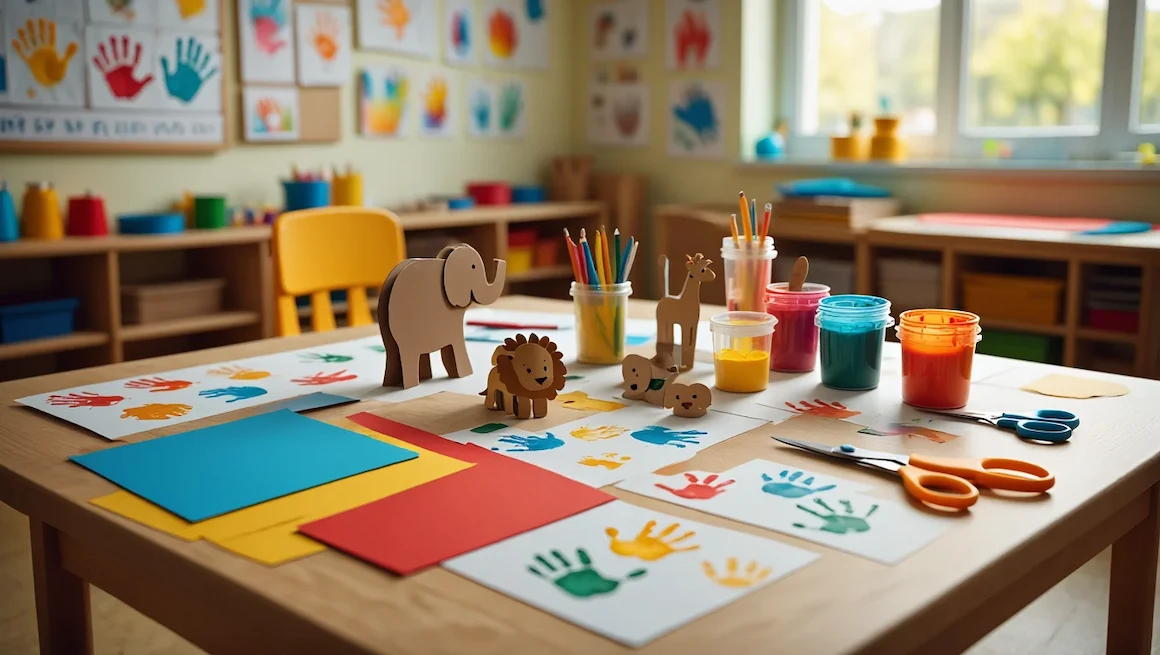Introducing children to letters through hands-on activities is one of the best ways to make learning fun and memorable. That’s why e crafts for preschoolers are a favorite among teachers and parents. With a focus on the letter “E,” these crafts help young learners improve letter recognition, build fine motor skills, and spark creativity. Whether you’re teaching in a classroom or looking for playful ideas at home, e crafts for preschoolers offer endless opportunities for discovery and joyful learning. In this post, you’ll find a collection of engaging and educational projects designed to support early literacy and keep little hands busy.
Why Letter E Crafts Matter in Preschool Early Literacy

Fostering early literacy in preschoolers goes beyond teaching the alphabet—it’s about creating memorable, hands-on experiences that help children connect with letters on a deeper level. Letter E crafts offer a playful introduction to phonics, vocabulary, and the joy of creative learning. By weaving art and language together, educators and parents can set the stage for lifelong reading skills and confidence.
Letter E crafts also present a chance to teach children about climate action and corporate responsibility. By choosing recycled materials or eco-friendly art supplies, you show young learners that creativity and caring for the planet can go hand in hand.
Practical ways e crafts for preschoolers support early literacy and environmental awareness:
- Phonics and Sound Recognition: Crafting with the letter E helps children associate the letter with its sound, using projects like “E is for Elephant” or “E is for Envelope.”
- Building Fine Motor Skills: Cutting, gluing, and assembling crafts improve coordination and strengthen small muscles needed for writing.
- Sustainable Art Choices: Use recycled paper, natural elements like leaves, or eco-friendly brands such as Crayola to model responsible resource use.
- Story Connections: Pair letter E crafts with reading sessions using books like “Chicka Chicka Boom Boom” to reinforce letter recognition.
- Group Collaboration: Create class murals or group “E” projects that highlight teamwork and the shared responsibility of making choices that benefit both the classroom and the environment.
By thoughtfully combining e crafts for preschoolers with a focus on literacy and sustainability, you’ll help children develop not just academic skills, but also a mindset that values creativity, responsibility, and community.
Essential Supplies for Easy and Fun E Crafts

Preparing the right materials makes all the difference when it comes to creative, engaging, and successful crafting sessions for preschoolers. The right supplies not only make projects more enjoyable but also teach children about making responsible choices—like selecting safe, eco-friendly options. Stocking up with versatile, sustainable materials means you’ll be ready for any e crafts for preschoolers, from simple collages to imaginative sensory projects.
Climate action and corporate responsibility start with the smallest choices—even at the craft table. By opting for recycled, non-toxic, and reusable supplies, you can model important values while giving kids the tools they need for artistic exploration.
Here’s a checklist of essential and eco-conscious supplies for any E-themed craft session:
- Recycled Construction Paper: Ideal for cutting out elephants, eggs, envelopes, and other “E” objects. Choose paper made from post-consumer materials.
- Child-Safe Scissors: Blunt-tip scissors allow preschoolers to cut safely and practice important fine motor skills.
- Eco-Friendly Glue Sticks: Select non-toxic, biodegradable glue for all sticking and assembling needs.
- Washable Markers & Crayons: Crayola offers markers and crayons made from recycled plastics, reducing environmental impact.
- Googly Eyes & Felt Scraps: Add personality to crafts with leftover felt and reusable googly eyes, promoting upcycling.
- Natural Elements: Encourage kids to use leaves, small sticks, or pebbles collected during nature walks as part of their E crafts.
- Printable Templates: Websites like Teachers Pay Teachers and Pinterest provide downloadable letter E templates—just remember to print on recycled paper.
- Reusable Craft Mats: Protect tables with washable mats, which can be used again and again to cut down on waste.
With these thoughtful supplies, e crafts for preschoolers become more than just a fun activity—they also serve as a lesson in creativity, sustainability, and responsibility. By making mindful choices, you’ll inspire young learners to appreciate both the art they create and the world around them.
Step-by-Step Guide: 20 Letter E Crafts for Preschoolers

Creating engaging art projects is one of the best ways to help children recognize letters and associate them with fun, hands-on experiences. This step-by-step guide to e crafts for preschoolers offers an exciting mix of activities that encourage creativity, reinforce early literacy, and support environmental responsibility. Each idea is designed to use easy-to-find, eco-friendly materials, making it simple for both classrooms and families to enjoy.
By incorporating climate action and corporate responsibility into your craft choices—like choosing recycled supplies or repurposing household items—you show children how creativity and caring for the planet go hand in hand. These e crafts for preschoolers are not only fun but also help nurture responsible habits from an early age.
Here are 20 inspiring, eco-conscious letter E craft ideas:
- E is for Elephant: Make an elephant using recycled paper and cardboard tubes.
- E is for Envelope: Craft mini envelopes out of old magazines or scrap paper.
- E is for Egg: Paint paper eggs with biodegradable paints and decorate with leaf prints.
- E is for Engine: Build a train engine using bottle caps, boxes, and reused buttons.
- E is for Earth: Create a 3D Earth using papier-mâché and newspaper scraps.
- E is for Eagle: Cut feathers from leftover felt and glue onto a paper eagle.
- E is for Excavator: Construct an excavator using egg cartons and colored paper.
- E is for Elf: Make a holiday elf puppet with recycled popsicle sticks and yarn.
- E is for Envelope Puppet: Turn a spare envelope into a silly talking puppet.
- E is for Eyes: Craft goofy eyes from paper plates and bottle caps for sensory play.
- E is for Engineered Bridge: Build simple bridges using straws and cardboard.
- E is for Eel: Use strips of fabric scraps and glue to make a wiggly eel.
- E is for Envelope Art: Decorate envelopes with stickers and drawings, then mail them.
- E is for Evergreen Tree: Craft a tree with reused green paper and twigs.
- E is for Eraser Stamp: Make simple stamps from old erasers for art prints.
- E is for Echo: Explore sound with a simple homemade echo tube using a cardboard roll.
- E is for Envelope Garland: String together mini envelopes for a classroom display.
- E is for Edible Art: Create snack-time art using safe, healthy food items shaped like E words.
- E is for Eagle Mask: Make a dramatic eagle mask with construction paper and leftover ribbon.
- E is for Eggshell Mosaic: Save clean eggshells to create a textured mosaic letter E.
With this variety of step-by-step e crafts for preschoolers, you can make learning the alphabet memorable, eco-friendly, and endlessly creative. Each project provides a chance to talk about the importance of using what we have and taking care of our world while having fun with art.
Teaching Tips and Early Learning Activities with E Crafts

Teaching with crafts is a powerful way to boost engagement, foster creativity, and help young children build lasting literacy skills. When you use e crafts for preschoolers, you not only reinforce the letter E but also bring lessons to life in a way that’s meaningful and memorable. By intentionally incorporating climate action and corporate responsibility into your teaching, you encourage children to make thoughtful choices and appreciate the value of sustainability in everyday life.
Using e crafts for preschoolers as part of your early learning curriculum is easy with the right strategies and a little creativity. Here are practical ideas to maximize the impact of your E-themed craft sessions:
- Integrate Phonics Games: Turn crafts into interactive learning by having children name objects that start with E during the activity (elephant, envelope, egg). This supports vocabulary and phonics recognition.
- Promote Group Collaboration: Create a large class mural where each child contributes an E-related craft, reinforcing teamwork and the importance of shared responsibility—mirroring principles of community and corporate responsibility.
- Incorporate Nature Walks: Before craft time, lead children on a short walk to collect leaves, twigs, or pebbles for their E crafts. This encourages environmental awareness and reduces reliance on store-bought supplies.
- Use Recycled Materials: Challenge students to find reusable materials at home or in the classroom, fostering climate action habits from an early age.
- Connect to Storytime: Pair E crafts with storybooks like “Chicka Chicka Boom Boom,” letting kids craft while listening for words that begin with E.
- Display and Celebrate: Showcase finished crafts on a classroom bulletin board or share them digitally with parents to build confidence and encourage family involvement in early literacy.
When educators and parents use e crafts for preschoolers in thoughtful ways, every project becomes a lesson not just in the alphabet, but also in caring for the world and each other. These teaching tips ensure that craft time is packed with opportunities for learning, environmental stewardship, and joyful exploration.
Family and Classroom Engagement: Sharing and Displaying E Crafts

Celebrating the hard work and creativity of young children is essential for building confidence and a sense of accomplishment. When you showcase e crafts for preschoolers in both the classroom and at home, you strengthen the connection between learning environments and encourage lasting family engagement. Displaying these projects also highlights the importance of making earth-friendly choices and supporting corporate responsibility by choosing sustainable display methods and materials.
Families and educators can work together to turn creative projects into community experiences that inspire pride and reinforce positive habits. Here are practical ideas for sharing, displaying, and maximizing the impact of e crafts for preschoolers:
- Create a Classroom Gallery: Dedicate a bulletin board or wall space to a rotating exhibit of e crafts for preschoolers. Use recycled materials for mounting and labels to model environmental responsibility and resourcefulness.
- Host a Family Craft Night: Invite families to participate in an evening where children present their e crafts for preschoolers and discuss the creative process. Serve snacks on compostable plates and encourage families to bring crafts made from upcycled items.
- Share Digitally: Take clear photos of children’s creations and upload them to a class blog, digital portfolio, or private social media group. This allows families who cannot visit in person to celebrate their children’s creativity and encourages ongoing family engagement.
- Incorporate Storytelling: Encourage children to share a short story or sentence about their craft. This blends literacy development with public speaking, all while centering the project as a source of pride.
- Community Displays: Collaborate with local libraries or businesses to showcase a collection of e crafts for preschoolers in public spaces. Choose display stands made from recycled or renewable materials and mention the project’s focus on sustainability.
By intentionally sharing and displaying e crafts for preschoolers, you create meaningful connections between school, home, and the wider community. These engagement strategies foster pride, celebrate eco-friendly creativity, and teach children that their art—and their choices—matter.
Conclusion
E crafts for preschoolers are more than just fun activities—they are powerful tools for early learning, creativity, and community building. By incorporating these projects into classrooms and homes, parents and teachers help children develop key literacy skills, strengthen fine motor abilities, and build confidence through hands-on exploration. Choosing eco-friendly materials and sustainable display methods for e crafts for preschoolers also teaches important lessons about climate action and responsibility. Whether shared on a classroom wall, at a family night, or online, these creative experiences foster connections and inspire a love for learning that will last well beyond preschool.


